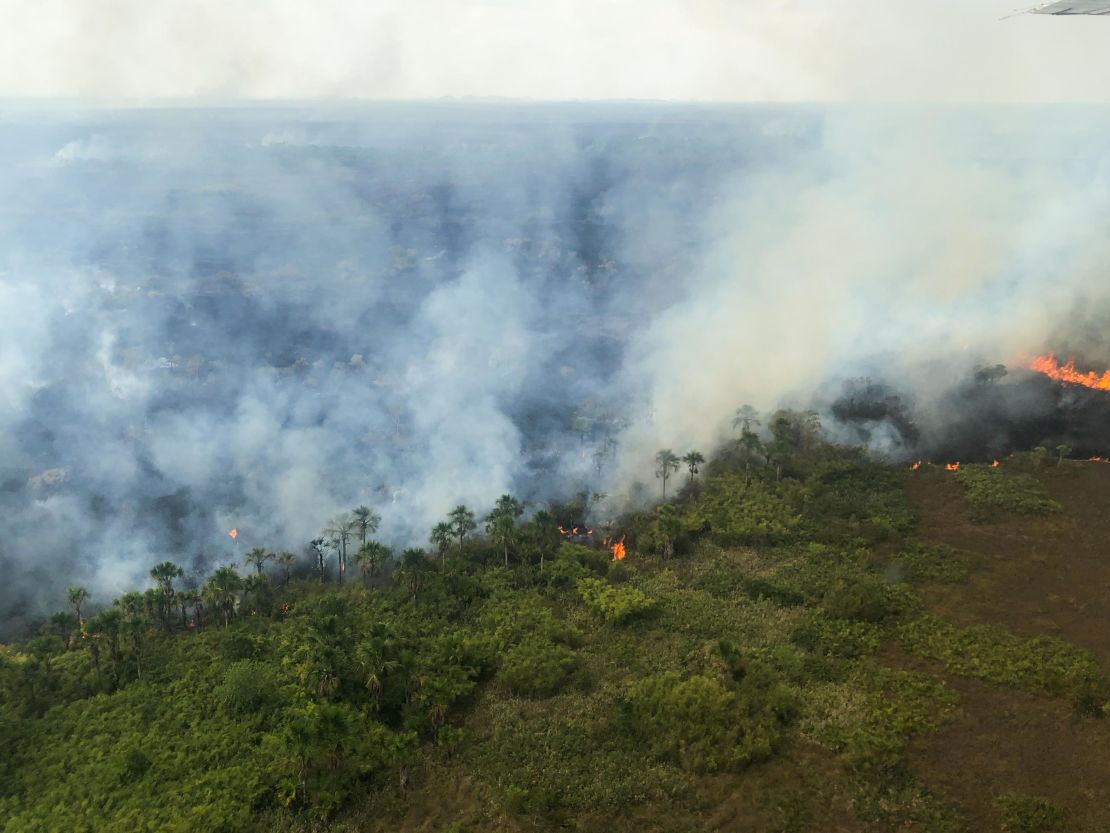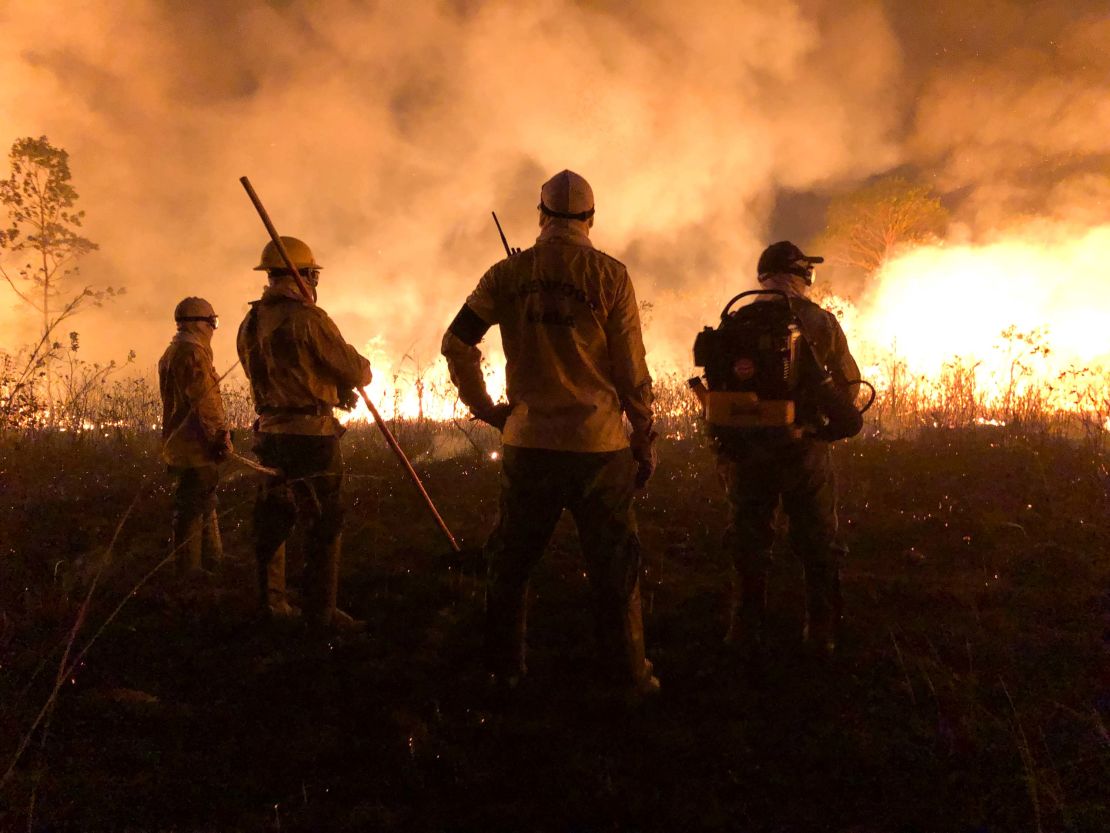Watch CNN’s live town hall on the climate crisis featuring 10 Democratic presidential candidates tonight beginning at 5 p.m. ET.
Soaring in a Cessna above the Amazon canopy isn’t meant to sting your eyes with smoke, soak your shirt with sweat, and cause your pilot to climb frantically just to get visibility back. Yet the fires raging over the past fortnight conjured what you’re never meant to witness: this is what the end of the world looks like.
A week spent driving around or flying over the vastness of South America’s largest blessing, leaves you stunned at how much damage has been done, and how fast. Is the Amazon edging towards its tipping point? When the moist forest canopy becomes so dry, and the savannah spreads, that fires propagate and expand in a vicious circle? Like much of climate science, we can only get learned warnings and then watch as reality often exceeds our initially modest concerns. It seems we don’t understand the planet well enough to be guessing at the timetable for our own extinction.
I didn’t ever think I would watch the Amazon burn in my lifetime, but now fear it’s just the start of the end. My editors asked me to write about what I thought at the end of the reporting. I’m used to miserable topics, but this is pretty dark.
Something extremely bad is happening very fast. And while it is often entirely Brazil’s fault – with the populist policies of its President Jair Bolsonaro fueling destruction that was cautiously limited by his predecessors, and farmers running riot, torching fields to clear land in the pursuit of cash – it is also not really their fault at all.
The soy they grow, the beef they farm, the wood they log, and everything else they tear from the Amazon, aren’t all used in Brazil. We buy them: Europe and central Asia about 19%, China 22%, North America 14%, according to the World Bank. Developed economies got that way through using up their own resources, and those of their colonies. So their diktats to Brazil as it develops, might better involve alternatives to deforestation – other ways to make money – than lectures. We could also stop buying their stuff too.
But the truth is, we don’t want to. You wouldn’t actually want to stop having a smartphone so you can “like” Leonardo DiCaprio’s post about the Komodo dragon, even though it uses metals mined appallingly. I didn’t refuse the stewardess’ offer of a 200ml cup of water despite it coming in foil-sealed plastic, with another plastic cup containing ice; the plane I am in is hot, and I am thirsty.

Uncomfortable choices
A lot of the choices we have to make to reverse course away from slow extinction are uncomfortable. They are also hard for politicians to impose on a population within a four- or five-year electoral cycle. The G7 nations didn’t grandstand about the Amazon in the French resort of Biarritz last month to herald a program of years of real climate action. It was instead an easy weekend’s posturing and point-scoring for a younger electorate.
There isn’t about to be wide-ranging change. Nobody wants to be the leader who made flying so expensive through a carbon tax, people can’t do it so much any more. Or who utterly bans single-use plastic, meaning your fruit is all mushy when you get it home. Talking about half-measures wins votes, not prohibitive and serious action. We really don’t want to change, and instead prefer to dream science will clean the seas, soak up the carbon, make endless smart energy, or let us fly off and pollute Kepler-452b.
The climate crisis business itself does nobody any favors. This way to hell is paved with earnest expertise. The models, the lifetimes of effort and application, the time limits for action, have led to a cul-de-sac of varying theories and estimates. There is so much white noise, nobody knows with authority what is the one thing we all have to do.
A lot of last week was spent arguing over whether the widely touted claim that 20% of the world’s oxygen is created by the Amazon was correct. Macron and Ronaldo had both used it. So did CNN, and other news organizations. There were screeds on Twitter. Climate scientists finding another burst of attention from disputing the number. Clickbait using this figure to suggest pretty much everything being said about the Amazon fires was inaccurate. It wasn’t. (And incidentally, it’s up to 20% of oxygen produced on Earth’s land that is estimated to come from the Amazon rainforests). There are few things more dangerous than false climate science, critics correctly argue, before hopefully realizing there’s little more dangerous in this emergency than a woeful and petty distraction.
I don’t usually cover the climate crisis, and I’m often grateful for that. Across the media landscape, it is often not the surest bet for editors to part with the tens of thousands of dollars needed to race off to the world’s remotest places and show the things people would rather not see, that make them shift uncomfortably in their desk chairs, and wish they were reading instead about Miley Cyrus and Liam Hemsworth’s breakup.
And it’s harder still to make the slow degradation of oceans, or the gradual razing of forests, seem like news. It isn’t new, there’s no reason to talk about it today especially, other than we should be talking about it every hour of every day. It’s been this bad for a while, we just have preferred not to talk about it at all. An older generation of news consumers doesn’t really care, until their kids tell them about it over the dinner table. A younger generation are so angry about it, they sometimes forget the need to do something practical, bar a few very cross commuters in capital cities on their way into work.
Climate is a business for many – a career – in much the same way as destroying it is for others. The Katowice summit for COP24 that I covered last year in Poland was a gentle cocoon, where urgency and politeness somehow co-exist. Most attendees drafting future pacts did so in a language of obfuscation and technicality almost guaranteed to alienate the swathes of popular opinion they need to alter.

Change will be unavoidable
To top that, most action plans over the climate crisis exist in the future tense. What we will do. How we have goals. What we must change. Then everyone orders another coffee, takes a taxi to the airport, gets back in their jet, orders beef on the plane, and carries on as before. We are also a bit exhausted by decades of the flailing of limbs and shrieking “emergency.”
It’s depressing watching the lungs of the earth burn. It isn’t going to stop until we stop buying the stuff it makes. And even then, we’ll need the resources from somewhere else. We will have to plant more trees. The scope of change – of diet, of consumer habits, of recycling, of technology, of political will – is too massive to expect in my lifetime. In fact, the steeper the spiral appears in front of us, the more stuff we will likely need to make us feel better – cooler, smarter, happier – in the worse days ahead.
The most obvious resolution will come in a few decades, when the heat gets too much, crops fail, clean water becomes more valuable than oil, and the things you were warned about start to kill a lot of people. Then change will be inevitable, and unavoidable, and the number of people all hoping for the same life of wow will sadly drop to something more sustainable.
It’s the issue of our time. It encompasses how far and fast we have journeyed as a species – just as our car starts to shake as it reaches its speed limit. That’s why we don’t like to talk about it. What comes next is simply uglier, and most of us would rather not say that out loud.


















